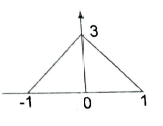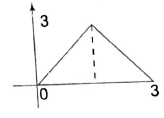Introduction to Signals MCQ
Introduction to Signals MCQ, Signals and Systems MCQ, Multiple Choice Questions on Signals, Energy Signal MCQ, Power Signal MCQ, Engineering MCQ, Electronics MCQ,
Multiple Choice Questions
Q.1. Which of the following signals is/are periodic?
- s(t)=\cos 2t+\cos 3t+\cos 5t
- s(t)=\exp (j8\Pi t)
- s(t)=e^{-7t}\sin 10\Pi t
- s(t)=\cos 2t \cos tu(t)
Answer: s(t)=\cos 2t+\cos 3t+\cos 5t & s(t)=\exp (j8\Pi t)
Q.2. Let δ(t) denote the delta function. The value of the integral .1.7,6(t)cos —2 dt is
- 1
- -1
- 0
- π/2
Answer: 1
Q.3. If a signal f(t) has energy E, the energy of the signal f (2t) is equal to
- E
- E/2
- 2E
- 4E
Answer: E
Q.4. The function x(t) is shown in the figure. Even and odd parts of a unit-step function u(t) are respectively

- \frac{1}{2}, \frac{1}{2}x(t)
- -\frac{1}{2}, \frac{1}{2}x(t)
- \frac{1}{2}, -\frac{1}{2}x(t)
- None of the above
Answer: \frac{1}{2}, \frac{1}{2}x(t)
Q.5. The period of the function \cos \frac{\Pi }{4}(t-1) is
- \frac{1}{8}sec
- 8 sec
- 4 sec
- \frac{1}{4}sec
Answer: 8 sec
Q.6. A signal x(t)=A\cos (\Omega _{0}t+\phi ) is
- An energy signal
- A power signal
- An energy as well as a power signal
- Neither an energy nor a power signal
Answer: A power signal
Q.7. x_{1}(t)=2\sin \Pi t+\cos 4\Pi t and x_{2}(t)=\sin 5\Pi t+3\sin 3\Pi t then
- x1 and x2 both are periodic.
- x1 and x2 both are not periodic.
- x1 is periodic, but x2 is not periodic.
- x1 is not periodic, but x2 is periodic.
Answer: x1 and x2 both are periodic.
Q.8. The signal x(t)=2(\cos \Pi t)+3\sin (2t)
- is periodic
- is not periodic
- may or may not be periodic
- none of the above
Answer: is not periodic
Q.9. The odd and even components of signal u(t) are
- \cos t , \sin t
- \sin t , -\cos t
- \cos t ,j \sin t
- \cos t ,-j \sin t
Answer: \cos t ,j \sin t
Q.10. The odd and even components of the sequence

- \left\{ 0.25,0,-0.25\right\},\left\{0.75,1,0.75 \right\}
- \left\{ 1.5,0,-1.5\right\},\left\{1.5,1,1.5 \right\}
- \left\{ 0.25,0,-0.25\right\},\left\{0.5,1,0.5 \right\}
- \left\{ 0.25,0,-0.25\right\},\left\{1.5,1,1.5 \right\}
Answer: \left\{ 0.25,0,-0.25\right\},\left\{0.75,1,0.75 \right\}
Q.11. The signal x(t)=e^{-2t}u(t) is
- power signal
- energy signal
- neither power nor energy signal
- either power or energy signal
Answer: energy signal
Q.12. The signal x(n)=\cos \frac{2\Pi }{3}nu(n) is
- causal, aperiodic
- causal, periodic
- non causal periodic
- non-causal aperiodic
Answer: causal, aperiodic
Q.13. The value of the integral \int_{-\infty }^{\infty }\delta (at-b)=
- \frac{1}{a^{2}}
- \frac{1}{\left| a\right|}
- \frac{1}{a}
- -\frac{1}{a}
Answer: \frac{1}{\left| a\right|}
Q.14. The time period of the signal x(t)=\cos 2\Pi t + \sin 5\Pi t is
- 2 sec
- 5 sec
- 10 sec
- 2.5 sec
Answer: 2 sec
Q.15. The signal x(n)=\cos 2n is
- periodic with period π
- periodic with period 2π
- periodic with period 4π
- aperiodic
Answer: aperiodic
Q.16. Consider the following signals x(t) and y(t ). The relation between x(t) and y(t) can be y(t)

- x(t+1)
- x(2t+2)
- x(t-1)
- x(2t-1)
Answer: x(2t+2)
Q.17. Represent the following signal as the sum of singularity functions

- -r(t)+2r(t)u(t-1)
- r(-t+1)+r(t-1)+2u(t-2)-r(t-2)
- r(-t+1)u(t)+2r(t-1)-r(t-2)-u(t-2)
- r(-t+1)u(t)+r(t-1)-r(t-2)-u(t-2)
Answer: r(-t+1)u(t)+2r(t-1)-r(t-2)-u(t-2)
Q.18. The rms value of the signal x(t)=10\cos \left ( 100t+\frac{\Pi }{3} \right )+16\sin \left ( 150t+\frac{\Pi }{3} \right ) is
- \sqrt{160}
- \sqrt{356}
- \sqrt{89}
- \sqrt{178}
Answer: \sqrt{178}
Q.19. For the signal x(t) shown in the figure which of the following is x(3t)





Answer: 